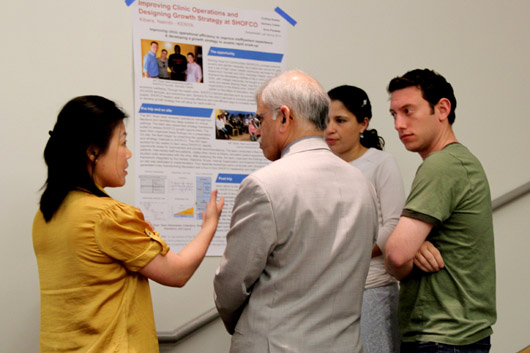In this section, Dr. Sastry describes the work that happens after students return from their on-site visits and the value in this kind of reflection after travel.

At the class finale, students had the opportunity to present their projects to a panel of esteemed guests. Image courtesy of MIT OpenCourseWare.
Returning to the Classroom
In that last month after students come back, I say to them, “You’ve done great work frantically in preparation and intensively on the ground, but I don’t want this to be the end. Now I want you to step back and develop some wisdom and judgment.” The first part is reflection: what worked, what did not, what was learned, where assumptions were proven correct, and where they were not. I also ask them to consider–if the goal is really to help and to turn an idea into practice–what they should do in these last few weeks to present something valuable to the host. This is when they can connect an idea to a different thread of work here at MIT, and take their thinking to another level. Sometimes this means refining and polishing something they have already done on the ground and linking it to some elements that they might do research on in the libraries here. It could also mean developing a new set of materials they had not even thought of until the end of their time on-site or the journey back. They might change the big presentation they originally envisioned to a set of posters, charts, or guidelines. Each team’s mentor enables the students to refine and deliver a final, carefully designed, and valuable piece of work back to the host.
Framing the last month like this for the students helps them develop as professionals-to-be. Students brief each other on their projects and can now learn from each other. We bring in thought leaders and have the students reflect on how their projects connect to bigger themes, whether it is healthcare delivery in the US or scaling up access to primary care in multiple countries. We create new levels of dialogue now that the trip is behind us, and it sets the stage for a really enriching set of discussions.
For me, this is the most fun part of the course, and it is the part that many other project-based courses do not have the luxury of doing. Many of the other ones tend to treat the trip as the capstone, and then you miss the opportunity for post-trip reflection. I have to admit that often there is a little less excitement from the students because the course has all been oriented toward the trip. Coming back, they might just be looking for the next exciting thing. But that is okay because it is part of my job as the instructor to get them to realize the value of this part of the course.
Student Follow-ups
Some of our hosts have realized how great our students are, and I have learned that many teams actually do extra work. I have had students email me well after the end of the course with another round of work, and this is where I step in as the instructor to ensure that students hand off what they have finished and close that loop to enable their reflection and learning. For this reason, this course finishes a few weeks before the full semester ends so that the students turn in their final deliverables prior to the end of the semester.
Work aside, what we actually see is that both the students and the hosts develop a real relationship with each other that continues naturally. When I have gone back to organizations that we have worked with, I have seen that a huge fraction our students–now alumni three, four, five years out–are still in touch with the hosts. They are still seeing them, talking to them, sitting on their boards, and advising them. And that is exciting!
Sloan Portfolio
The students also turn in a deliverable that is oriented toward the class as a whole. While they already write personal reflections on what they have learned as managers-to-be, this class-oriented work is guided by what they imagine future students or others might want to use. It could be blog-style documentation of their project, a mini-case, a downloadable module, a guide to patient flow mapping by observation, or a guide to improving documents. As a result, we have a really rich set of materials that the students generate. I think that act of going beyond their individual project helps students broaden their perspective. It ensures that the course links to their future experiences, whether as students or in the real world. So many of our students at MIT do amazing work, but they need opportunities to develop their skills at framing and presenting what they have done. It is not just to self-promote but to lead and help others to learn.








